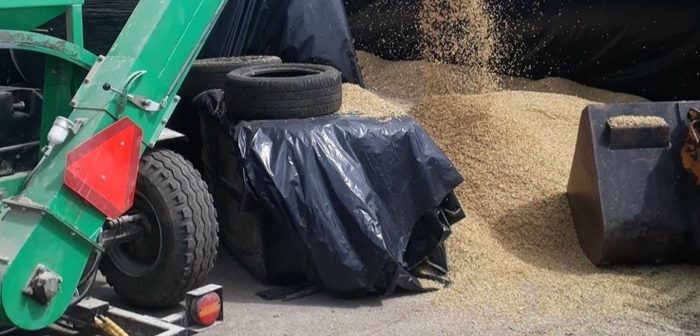Many cereal growers who harvest and store grain for home use, have been warned of a severe nationwide shortage of products containing propionic acid. These products – which are widely used for grain preservation, allowing safe storage at moisture contents of up to 30% – are said to be selling at up to 50% more than their price last year.
However, alternatives are available, which feed preservation specialists, Kelvin Cave Ltd, advise should be chosen with care, depending on the grain’s storage options and end use.
These will be appropriate for growers across the entire UK, but are particularly relevant in the north of England and Scotland, where a lot of spring cereal growers traditionally treat their grain.
Michael Carpenter, Kelvin Cave’s northern manager, says harvesting cereals early and crimping is the best option nutritionally and has many advantages when it comes to agronomy and livestock performance. However, moist feed such as crimp may not suit all feed-delivery systems.
Benefits of Propcorn
He says: “The non-corrosive propionic acid product, Propcorn NC, is popular for many reasons, one of which is its good flow characteristics through ad lib hoppers.
“Further advantages include the option to either store Propcorn NC-treated grain whole or rolled, loose in a shed, without the need to ensile.
“Harvest is also more flexible than dry grain harvest, potentially taking place slightly earlier and, if necessary, in wetter conditions. This means the harvest day is slightly longer, potentially – if combinable – while there is surface moisture from dew or rain on the grain.”
However, Propcorn NC, like other propionic acid-based products, has sold out in many places this summer.
Alternatives to Propcorn
Some alternative options retain many of the benefits of Propcorn NC, including crimping, which uses the grain when dry matter yields are up to 20% higher and the grain is more digestible. The process involves rolling the grain on the day of harvest and applying a crimping preservative, such as CrimpSafe 300. It is then compacted and stored in a clamp in anaerobic conditions, in a similar way to silage.
CrimpSafe Hi-Dry
“However, traditionally crimped grain, at moisture contents of 25-45% will not flow through the ad lib hoppers popular in some beef finishing systems,” he says. “For these circumstances, the best option could be CrimpSafe Hi-Dry, which is specifically formulated to preserve grain harvested below 30% moisture.
“At the drier end of this range, it will have better flow characteristics than traditional, higher moisture crimp,” he says.
“There are huge agronomic and nutritional advantages to the earlier harvest and moist preservation associated with crimp, including higher digestibility and palatability for ruminants and less disease in the crop,” he says. “This is particularly relevant where some fungal diseases are reported to be exploding this year.”
Higher moisture straw
However, he adds: “It may be necessary to treat straw with BaleSafe, but this allows it to be stored unwrapped at a higher moisture, and its digestibility when harvested earlier is higher than that of conventional straw, improving its use as feed.
“However, in all cases, the grain preservative used should be chosen with care to ensure it suits the farming system, and that all of the benefits are realised,” he says.
For advice about options for grain preservation, please contact Kelvin Cave Ltd on 01458 252281 or Michael Carpenter on 07817 977701.
Moist grain preservation and storage options
| Product | Grain moisture | Storage options |
| Unbuffered propionic acid | 14-28% | Rolled or whole, aerobic in shed or bunker |
| Propcorn NC | 14-28% | Rolled or whole, aerobic in shed or bunker |
| CrimpSafe 300 | 24-45% | Rolled and ensiled in clamp or tube, anaerobic |
| CrimpSafe Hi-Dry | 14-30% | Rolled and ensiled in clamp or tube, anaerobic |




